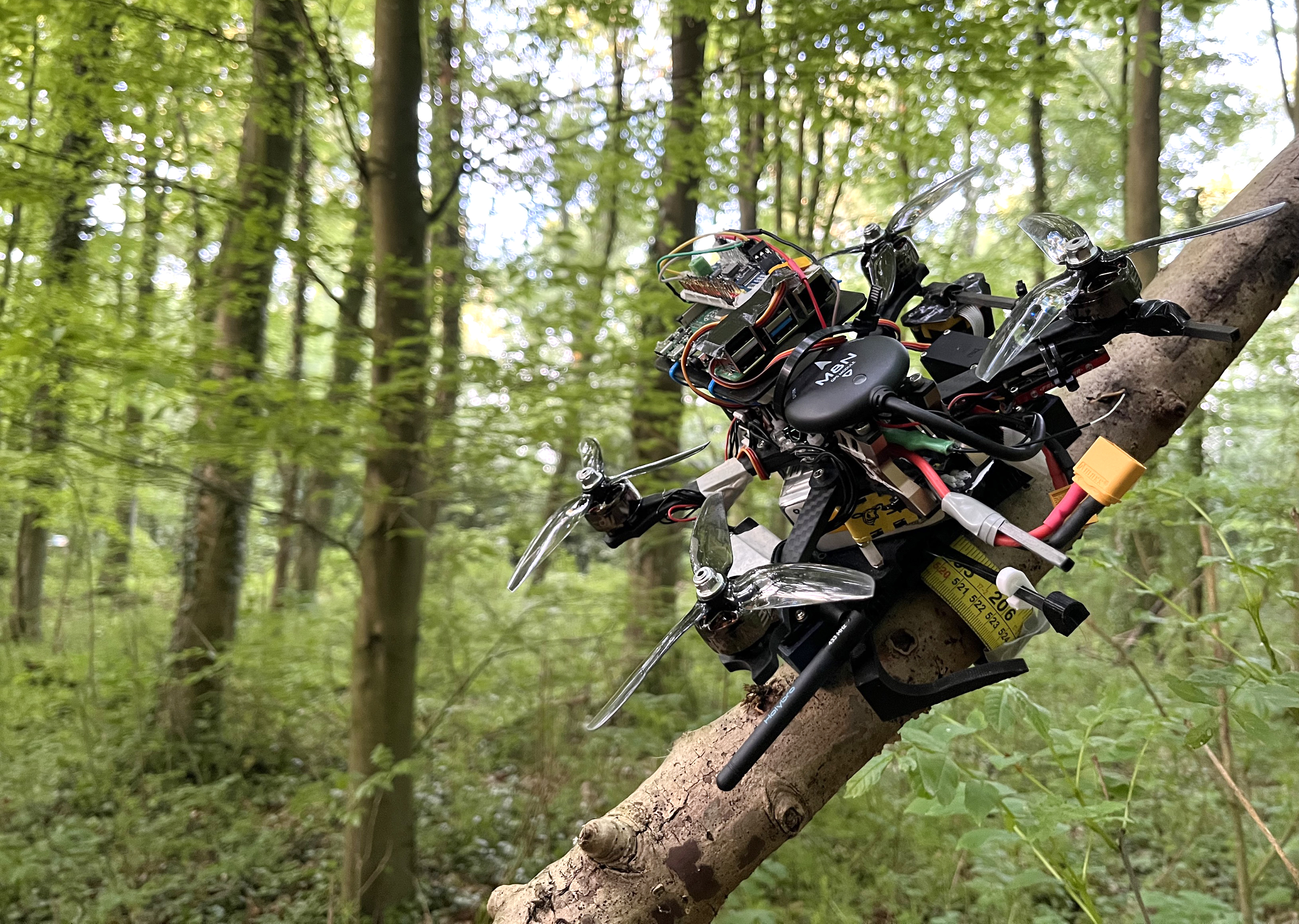Flying robots survey biodiversity and climate inside tropical rainforests
In the sweltering and humid tropical rainforest, a vibrant ecosystem thrives. Birds of paradise, monkeys, bats, and insects harmoniously move about in the tree canopy, all making their own distinctive sounds. But then, a newcomer arrives: a small quadcopter drone hovers through the foliage, looking for a branch to land on. The animals become quiet now. The drone agilely touches down, swiftly grabbing the branch with its gripper. It powers down the loud motors and quietly, but intently, starts to listen to the world around it, which slowly comes back to life again.
TU Delft’s Assistant Professor Salua Hamaza and students Liming Zheng and Seamus McGinley have developed an innovative research platform for long-term bioacoustics surveys: a lightweight drone capable of perching on tree branches and a custom-made 2-gram audio sensor to record a wide range of sounds - from birds active during daytime, to nocturnal bats.
Together with researchers from ETH Zurich and Aarhus University they have developed a team of robots to survey 100 hectares of rainforest in a remarkably short time of 24 hours. Their collaboration, bringing together engineers and ecologists, led them to participate in the semifinals of the worldwide XPRIZE Rainforest competition held in Singapore on June 9. The team eagerly awaits the announcement to know if they have secured a spot in the finals in Borneo, competing for a whopping 10 million dollars prize.
Fleet of robots
ETHBioDivX is a multi-disciplinary team championing collaborations between experts in Robotics and Ecology from across the world, tasked to collect rainforest data and samples, to uncover meaningful insights that help with our planet’s longevity. To achieve so, a fleet of robots and instruments gathered visual, audio, and environmental DNA data, to unveil the different taxonomies of the animal and plant kingdoms inhabiting the wet rainforest.
New bioacoustics drone concept
Bioacoustics monitoring is a risky and time-consuming endeavor conducted by biologists climbing trees over 50 meters high, and manning the acoustic instrumentation up in the canopy for days on end. To automate this task, robotic technologies can be used instead, for example, using agile multi-rotor drones that are small and capable of infiltrating tree branches. However, the loud spinning propellers of drones make such recordings impossible to obtain in flight.
To overcome this limitation, the team devised a new drone concept designed to land on tree branches. This drone can power off its propellers, enabling it to quietly record audio data for prolonged time without disturbing the surrounding animals. By perching, the drone not only captures forest sounds high up in the trees – where the highest concentration of birds take rest – but it can also accomplish this with its motors shut off, prolonging its mission while preserving battery life.
Drones capable of physical interaction with the surroundings can deliver a tangible impact on our efforts against climate change.
Assistent Professor Salua Hamaza
Complex environments
The bioacoustics drone incorporates a clever design that allows it to rapidly grasp tree branches in the canopy using a compliant bi-stable mechanism. On top of that, real-time control and sensing ensure that the drone behaves reliably while physically interacting with unknown objects and avoiding getting entangled in the dense vegetation. To push the boundaries of what is achievable with drones in complex environments, software and control are not enough by themselves, and a renewed effort in design can extend drones‘ potential to new frontiers, enabling them to interact with their surroundings naturally, like animals do. Lastly, battery technology and radiolink communication are still some of the main technology bottlenecks for multi-rotors operating outdoors, for which further research and development are needed.
Climate change
Our planet faces a great climate and ecological crisis. By protecting our forests, we are not only preserving a self-sustained way to capture emissions, but also, we are nurturing an important buffer against climate change. To help forests thrive, scientists are gathering ecological insights related to biodiversity and climate in forests at micro and macro scale, to incentivize immediate climate actions.
Impact for a better society
By combining innovative technologies in engineering and ecology, the team ETHBioDivX is set out to quantify and measure biodiversity, integrating the knowledge from academics, entrepreneurs, and local communities and ultimately advise policy makers all around the world on what and where to take actions. TU Delft joins this mission to advance impact for a better planet and society.
Next steps
The research group at the BioMorphic Intelligence Lab headed by Salua focuses on enhancing drones’ autonomy by exploring new morphologies that enable higher mobility and versatility. This includes drones with limbs capable of climbing trees, building nests, cleaning forest floors, or collecting samples of foliage, bark, water, and soil.




